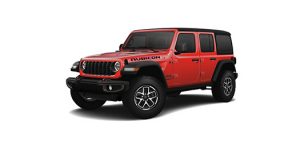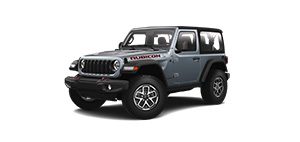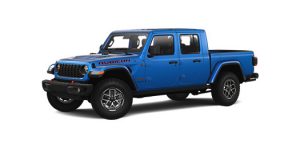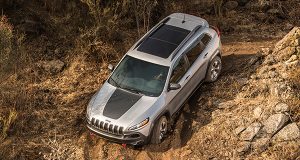1990-1999
The All-New 1993 Jeep® Grand Cherokee (ZJ) set a new industry benchmark thanks to its unique balance of on- and off-road capability. The super-capable Wrangler (TJ) with its new coil suspension was introduced in 1997. In 1999 the new Grand Cherokee (WJ) was marketed as the most capable SUV ever. Sales soared to 629K units for the decade.
LUXURIOUS SUVS
After about 30 years, the classic Grand Wagoneer gave way to a “Final Edition” model in 1991. An All-New Jeep® Grand Cherokee launched in 1993 and was a larger and more luxurious cousin to the Cherokee–with a smoother motorway ride and a more spacious interior. An All-New Jeep Wrangler (TJ) was introduced in 1997–that looked very similar to the CJ-7. The TJ used a four-link coil suspension and featured a new interior. In 1998, the German Daimler-Benz merged with the Chrysler Corporation (including the Jeep Brand) for $36 billion.
AUTHENTIC TO THE CORE
1993-1995 JEEP® GRAND CHEROKEE (ZJ)
AWARD-WINNING SERIES OF 4X4S
The Grand Cherokee (ZJ) famously first appeared by crashing through the convention center glass at the North American International Auto Show in Detroit during its introduction there on Jan. 7, 1992. The Grand Cherokee replaced the Wagoneer as a mid-sized luxury SUV–a design class many automakers would rush to imitate.
1993 Jeep® Grand Cherokee (ZJ).
The first SUV equipped with a driver side airbag, it set new standards for on-road ride, handling and comfort in an SUV. The Grand Cherokee was immediately popular and won dozens of awards, including Motor Trend magazine’s Truck of the Year , Four Wheeler magazine’s Four Wheeler of the Year and 4Wheel & Off-Road magazine’s 4x4 of the Year for 2003.
1993 Jeep® Grand Cherokee (ZJ).
New for ’93, the 105.9-inch-wheelbase Grand Cherokee took refinement to a new level. A new Quadra-Coil™ suspension featured a coil/multilink configuration. A 5.2L V8 engine was offered as an option, and a Dana 44 rear axle was available for some models.
1993 Jeep® Grand Cherokee (ZJ).
ZJs originally came in three trims options: Base, Laredo, and Limited. Specialty models included the Orvis (1995-97), a Limited custom with an exterior color scheme of hunter green with gold striping. Its interior sported two-tone green and champagne seats complimented with red accents and Orvis badging.
Jeep® Grand Cherokee Orvis model.
1993 JEEP® GRAND WAGONEER (ZJ)
A FRESH GRAND WAGONEER
The Jeep® Grand Wagoneer ZJ was a rare version of the Grand Cherokee that was offered only in 1993.
The Grand Wagoneer was a top-of-the-line package that offered every ZJ option, including the V8, as well as a look that harkened back to the recently deceased “SJ” Grand Wagoneer. The Grand Wagoneer (ZJ) was offered as a totally separate model, the woodgrain side setting it apart.
1993 Jeep® Grand Wagoneer (ZJ).
1997-2006 JEEP® WRANGLER (TJ)
GREAT AMERICAN FREEDOM MACHINE
Considered the Ultimate Escape Machine, the 1997 Jeep® Wrangler (TJ) offered outstanding on-road handling and legendary off-road capability. The All-New 1997 Jeep® Wrangler was the fifth Jeep Brand vehicle to win the “4x4 of the Year” award.
The new Wrangler had a retro-look very similar to the CJ-7, but was very different from a mechanical standpoint. Nearly 80 percent of the vehicle parts were newly designed. Starting with the basic Wrangler platform, Jeep® Brand engineers gave the Jeep Wrangler the most thorough overhaul since the Quad evolved into the MB.
The biggest engineering change on the TJ was the new Quadra-Coil™ suspension, which replaced standard leaf-springs and provided a greatly improved on-road ride. Off-road capabilities were enhanced with increased axle articulation, ground clearance and more aggressive approach and departure angles. The TJ also featured a new interior, including driver and passenger airbags. The TJ retained several classic Jeep® Brand features such as round headlights (no longer square), a fold-down windshield (first seen in 1940) and removable doors, as well as a choice of a soft top or removable hardtop. A factory-fitted sport bar was also standard. The TJ engine is the same 4.0L AMC Straight-6 used in the Cherokee and Grand Cherokee.
The TJ Wrangler line has garnered rave reviews since its debut and is proving to be an extremely adaptable trail vehicle, with a growing variety of aftermarket performance parts now available.
In 2003, the Jeep® Brand introduced the most capable Wrangler ever—Rubicon. The new model was named for the famed Rubicon Trail in the Sierra Nevada Mountains. The Rubicon model featured Dana 44 axles, air actuated Tru-Lok® front and rear lockers, Rock-Trac® 4x4 System, 31-inch Goodyear® MT/R off-road tires, four-wheel disc brakes and diamond-plate rock rails.
The Wrangler Unlimited debuted in late 2004 with a longer wheelbase, 13 inches more cargo room and enhanced on-road riding comfort. In 2005, the Jeep® Brand introduced the Rubicon Unlimited–it featured the wheelbase of the Unlimited and off-road features of the Rubicon.





